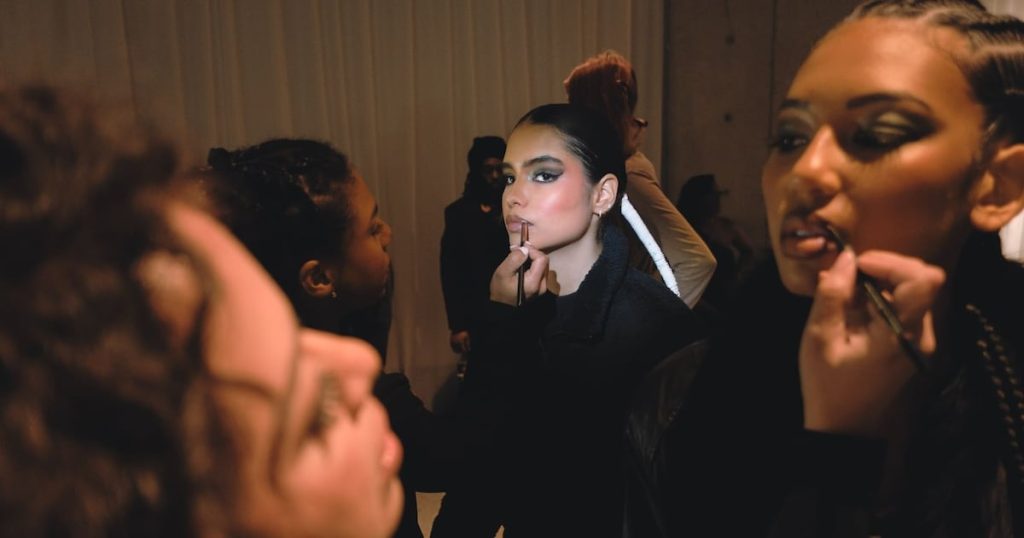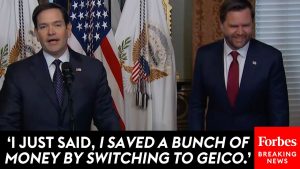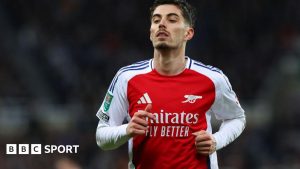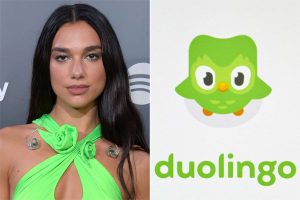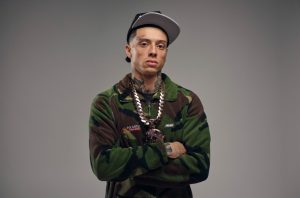A decade ago, blue-chip beauty brands owned the New York runways, with makeup brands like MAC, Nars, Maybelline and Covergirl sponsoring the lion’s share of shows, using them to tease products or raise the profiles of their contracted artists.
This season, however, it’s indie beauty brands that are getting the bulk of the attention.
The most memorable looks of the current season, from Collina Strada’s leopard spots and jewel-toned accents (care of clean-girl staple Ilia Beauty) or Thom Browne’s freakish feathered eyes (from the eyelash startup Lashify) came from brands rarely, if ever, seen before on the runway.
The practice of “skincare sponsors,” which emerged in the late 2010s, also continued apace. Runway makeup artists, like Pat McGrath or Charlotte Tilbury, were once lauded for creating gorgeous skin on the runway; now, brands like Peach & Lily, Facile and 111Skin have set up shop backstage, hoping to link modelesque skin with their acids and masks.

For all of them, fashion week is still a marketing exercise — a way to elevate their products and gift them to models, influencers and other tastemakers. But the changing atmosphere has inspired optimism among some longtime artists that fashion week beauty could return to its once-experimental roots.
Joseph DiMaggio, a hairstylist and founder of hair collective Shokunin Clik, counted this as his 33rd New York Fashion Week backstage, and his first working with Italian haircare brand Duomo, which made its runway debut this season in New York.
“It’s evolving and changing,” he said, after approving the jasmine buds that were to be woven into braids at Bibhu Mohapatra. “In the past, it got really boring. Fashion Week is about going for it. I feel like we’re getting back to that.”
The Beauty Bell Curve
Backstage was a simpler place back in the 1990s, when Tilbury and McGrath were cutting their teeth. Fashion and beauty media’s proliferation — in magazines, then in blogs — helped draw the attention of beauty advertisers, creating the 2000s and 2010s backstage ecosystem that resembled something between a trade show and a factory floor churning out gorgeously made-up human beings.
But those returns have diminished, as evidenced by big brands’ divestment from the runway. While some labels, like Clinique and Covergirl, have ceased to sponsor shows entirely, others have greatly reduced their exposure on the New York runways. MAC, which once officially sponsored the various international fashion weeks (and supplied over 850 shows worldwide every year) has lately sponsored just a handful of individual shows, including Kim Shui, Luar and Christopher John Rodgers. Nars, a former backstage mainstay, worked exclusively on Khaite this season. Tresemmé was the only beauty brand to serve as an official NYFW sponsor, while Maybelline, which served as a sponsor last September, not only abandoned that role but didn’t appear at a single show so far in 2025.

Sponsorship can cost as little as $10,000 and as much as $50,000-plus based on a variety of factors (size of brand, gift bag inclusion) not including supply of labor or product. This economy is crucial for fashion designers seeking to offset the six-figure costs of their productions. But as the relevance of runway beauty is ceded to TikTok creators and rapid microtrends, big brands are less confident the investment is worth it. As one communications professional put it, “our marketing spend can go a lot farther elsewhere.”
For indie brands, however, an NYFW sponsorship can elevate a brand toward high fashion, one of the reasons false eyelash brand Lashify started getting involved in 2024. Working with designers and makeup artists allows the brand to experiment with “crazy editorial stuff that isn’t necessarily going to take off in the market,” said Sahara Lotti backstage at Thom Browne.
Working with emerging designers also provides a more natural fit for a burgeoning beauty label. Kallmeyer, a New York label increasingly known for its elevated basic clothing, staged its second show this season sponsored by Saie, a New York label increasingly known for its elevated basic makeup.
“I’m a younger designer, so it’s a little bit more difficult getting those bigger sponsors,” Nigerian designer Tia Adeola said backstage at her show in Brooklyn, where a plentiful display of chartreuse gift bags from Serena Williams’ Wyn Beauty held court in the middle of the dressing area. “Which is why I’m grateful for Wyn.”

The show’s look emphasized the lip liners and glosses new to Wyn’s collection, which were gifted at the show and after-party. “We were looking for an organic partnership,” said Derin Masha, Wyn’s head of brand.
The LA-based skincare brand Facile also made its runway debut this season, at Sandy Liang, staffing estheticians to give models facials with their Destress or Brighten serums.
The opportunity to partner with the designer, and expose their product to her fashion-forward cohort, was an “invaluable” tool for building their brand awareness, said co-founder Danielle Nadick Levy.
Art Partners
Though not so much a destination for boldfaced brands, New York Fashion Week remains a hive for boldfaced artists — and provides an opportunity for indie labels to access them.
For years, the makeup artist Dick Page served as Shiseido’s artistic director, and often worked on behalf of the label. This season, the artist was contracted by Ilia Beauty for the Collina Strada show, where he created leopard spots with the brand’s Eye Stylus eyeshadow sticks, which are set to launch on Feb. 17 and were promoted using backstage footage on the brand’s Instagram and TikTok channels.


But one of the most surprising match-ups occurred at the tail end of NYFW, courtesy of the experimental makeup artist Isamaya Ffrench and Lashify. The show’s themes, which combined birdlike textures with academic fabrics and textures, were reflected in spindly feathered eyelashes colored black, yellow or green. Some models received a necktie painted across their lips. “Thom loves to do different characters,” Ffrench said backstage.
“One of the issues with Fashion Week in general is, we only have about three hours to do a makeup look,” Ffrench said. “We get a whole day with Thom’s show, so we get to do something really extraordinary. I think there are some real key shows that do stand out and still are relevant. Thom is one of them.”

While Bobbi Brown the brand took care of makeup at Altuzarra, Bobbi Brown the artist made her return to NYFW with her new label, Jones Road, as a first-time sponsor. At cashmere line Lingua Franca’s show, held at the Bowery Hotel, Brown and her team painted a cast of models that included Jenna Lyons, Pat Cleveland and Molly Ringwald. Instead of one show-wide look, Brown asked the models what kind of makeup they usually wore, and did her best to replicate it for the show.
It was Brown’s first time backstage after nearly a decade. Was it also, perhaps, a signal that runway beauty had returned?
“I haven’t really looked at Fashion Week in all the years I’d been not doing it,” Brown said, rubbing a tawny shade of Miracle Balm into Lyons’ cheeks. “All I could say is, I would hope so!”
Sign up to The Business of Beauty newsletter, your complimentary, must-read source for the day’s most important beauty and wellness news and analysis.



